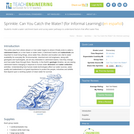
Students model a water catchment basin and survey water pathways to understand factors that affect water flow.
- Subject:
- Education
- Material Type:
- Lesson Plan
- Provider:
- TeachEngineering
- Provider Set:
- TeachEngineering
- Date Added:
- 10/14/2015


Students model a water catchment basin and survey water pathways to understand factors that affect water flow.
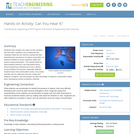
Students drop marbles into holes cut into shoebox lids and listen carefully to try to determine the materials inside the box that the marbles fall onto, illustrating the importance of surface composition on dolphins' abilities to sense materials, depth and texture using echolocation. This activity builds on what students learned in the associated lesson about bycatching by fisheries and how it affects marine habitats and species, especially dolphins. Students learn how echolocation works, why certain animals use it to determine the size, shape and distance of objects, and how people can take advantage of dolphins' echolocation ability when developing bycatch avoidance methods.
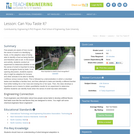
Few people are aware of how crucial the sense of smell is to identifying foods, or the adaptive value of being able to identify a food as being familiar and therefore safe to eat. In this lesson and activity, students conduct an experiment to determine whether or not the sense of smell is important to being able to recognize foods by taste. The teacher leads a discussion that allows students to explore why it might be adaptive for humans and other animals to be able to identify nutritious versus noxious foods. This is followed by a demonstration in which a volunteer tastes and identifies a familiar food, and then attempts to taste and identify a different familiar food while holding his or her nose and closing his or her eyes. Then, the class develops a hypothesis and a means to obtain quantitative results for an experiment to determine whether students can identify foods when the sense of smell has been eliminated.
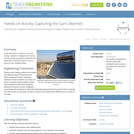
In the exploration of ways to use solar energy, students investigate the thermal energy storage capacities of different test materials to determine which to use in passive solar building design.
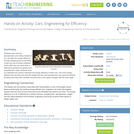
Students learn how the aerodynamics and rolling resistance of a car affect its energy efficiency through designing and constructing model cars out of simple materials. As the little cars are raced down a tilted track (powered by gravity) and propelled off a ramp, students come to understand the need to maximize the energy efficiency of their cars. The most energy-efficient cars roll down the track the fastest and the most aerodynamic cars jump the farthest. Students also work with variables and plot how a car's speed changes with the track angle.
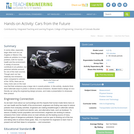
In some cities, especially large cities such as Los Angeles or Mexico City, visible air pollution is a major problem, both for human health and the environment. A variety of sources contribute to air pollution, but personal vehicles account for one of the main sources. Though each car has relatively low emissions when compared to vehicles of the 1970s, there are so many more cars on the road now that their emissions play a large role in overall pollution. In this activity, students think about alternate ways to power a vehicle to reduce emissions. Student teams design an eco-friendly car using the engineering design process, and make a presentation to showcase their product.
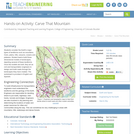
Students consider the Earth's major types of landforms such as mountains, rivers, plains, hills, canyons, oceans and plateaus. Student teams build three-dimensional models of landscapes, depicting several of these landforms. Once the models are built, they act as civil and transportation engineers to design and build roads through the landscapes they have created. The worksheet is provided in English and Spanish.
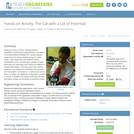
Working in teams of three, students perform quantitative observational experiments on the motion of LEGO MINDSTORMS(TM) NXT robotic vehicles powered by the stored potential energy of rubber bands. They experiment with different vehicle modifications (such as wheel type, payload, rubber band type and lubrication) and monitor the effects on vehicle performance. The main point of the activity, however, is for students to understand that through the manipulation of mechanics, a rubber band can be used in a rather non-traditional configuration to power a vehicle. In addition, this activity reinforces the idea that elastic energy can be stored as potential energy.
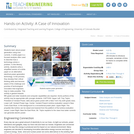
Students learn about power generation using river currents. A white paper is a focused analysis often used to describe how a technology solves a problem. In this literacy activity, students write a simplified version of a white paper on an alternative electrical power generation technology. In the process, they develop their critical thinking skills and become aware of the challenge and promise of technological innovation that engineers help to make possible. This activity is geared towards fifth grade and older students and computer capabilities are required. Some portions of the activity may be appropriate with younger students. CAPTION: Upper Left: Trey Taylor, President of Verdant Power, talks about green power with a New York City sixth-grade class. Lower Left: Verdant Power logo. Center: Verdant Power's turbine evaluation vessel in New York's East River. In the background is a conventional power plant. Upper Right: The propeller-like turbine can be raised and lowered from the platform of the turbine evaluation vessel. Lower Right: Near the East River, Mr. Taylor explains to the class how water currents can generate electric power.
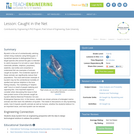
Bycatch can be defined as the act of unintentionally catching certain living creatures using fishing gear. A bycatched species is distinguished from a target species (the animal the gear is intended to catch) because it is not sold or used. Marine mammals (whales, dolphins, porpoises), seabirds, sea turtles and unwanted or undersized fish are some examples of animals caught as by-catch The incidental capture of these animals can significantly reduce their populations. The most well known example of by-catch may be the unintentional mortality of spotted and spinner dolphins in the tuna fishing industry. "Dolphin-Safe" tuna was a result of this interaction (Be prepared to discuss how this came about with students, as it is something close to their daily lives). One important aspect to consider when discussing this issue is that laws protect some of the animals caught as by-catch (Marine Mammal Protection Act and Endangered Species Act). In this lesson, students will first be shown pictures of entangled marine animals and will discuss the definition of by-catch This will lead to discussions on why by-catching exists, how it impacts specific animals as well as humans, whether the students believe it is an important issue, and how by-catch can be reduced.
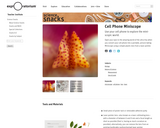
Use your cell phone to explore the mini-scopic world. Open your eyes to the amazing world of the ultra-tiny when you convert your cell phone into a portable, picture-taking Miniscope using a simple plastic lens from a laser pointer.
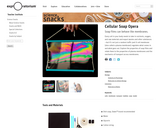
Every cell in your body needs to take in nutrients, oxygen, and raw materials and export wastes and other substances—but it’s not just a random traffic jam! A cell membrane (also called a plasma membrane) regulates what comes in and what goes out. Explore the properties of soap films and relate them to the properties of plasma membranes and the mechanics of transport across membranes.
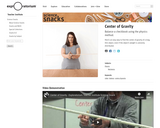
Here’s an easy way to find the center of gravity of a long, thin object, even if the object’s weight is unevenly distributed.

Student groups compete to design a process that removes the most iron from fortified cereal. Students experiment with different materials using what they know about iron, magnets and forces to design the best process for removing iron from the cereal samples.
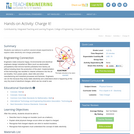
Students use balloons to perform several simple experiments to explore static electricity and charge polarization.
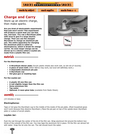
In this activity about electricity, learners produce a spark that they can feel, see, and hear. Learners rub a Styrofoam plate with wool to give it an electric charge. Then, they use the charged Styrofoam to charge an aluminum pie pan. Essentially, learners build an electrophorus (Greek for "charge carrier"). This resource also contains instructions on how to build a large charge carrier called a "Leyden Jar" using a plastic film can.
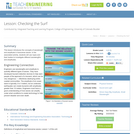
This lesson introduces the concepts of wavelength and amplitude in transverse waves. In the associated activity, students will use ropes and their bodies to investigate different wavelengths and amplitudes.
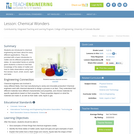
Students are introduced to chemical engineering and learn about its many different applications. They are provided with a basic introduction to matter and its different properties and states. An associated hands-on activity gives students a chance to test their knowledge of the states of matter and how to make observations using their five senses: touch, smell, sound, sight and taste.
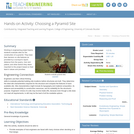
Working in engineering project teams, students evaluate sites for the construction of a pyramid. They base their decision on site features as provided by a surveyor's report; distance from the quarry, river and palace; and other factors they deem important to the project based on their team's values and priorities.
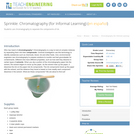
Students use chromatography to separate the components of ink.